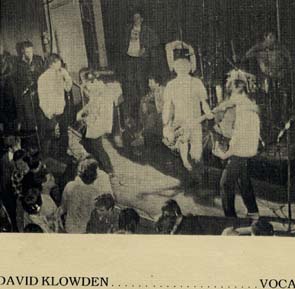 David Klowden — 5051 and Tell-Tale Hearts veteran turned author and professor — kindly sent me the manuscript of “Wild in the Streets of Slow Death,” his novel about coming of age in the San Diego punk scene ca. 1980. I read it in one sitting and enjoyed it immensely on several levels.
David Klowden — 5051 and Tell-Tale Hearts veteran turned author and professor — kindly sent me the manuscript of “Wild in the Streets of Slow Death,” his novel about coming of age in the San Diego punk scene ca. 1980. I read it in one sitting and enjoyed it immensely on several levels.
It’s a great portrayal of teenage alienation and redemption; an authentic memoir of our own youth culture, full of characters and events based on that time and place; and a crime thriller informed by the police excesses, white-supremacist fringe elements, bad drugs and internecine battles that made the San Diego underground such treacherous terrain. I’m glad David and the rest of us negotiated it!
I’m very much looking forward to seeing that in print.
If you read the book We Got The Neutron Bomb, you’ll see it’s nothing compared to Los Angeles.
http://www.art-for-a-change.com/Punk/psketch4.htm
The SDPD were known for violently overreacting and treating everything with an “us vs them” mentality. I think the SDPD thought they were untouchable, something I’ve never found to that extent anywhere else. I think the SDPD had as well known a reputation for senseless violence as the SD punk scene did. Which actually kind of makes a little sense.
They violated my rights and strong armed me many times, bullying and threatening to pin crimes on me that I didn’t do. Officer Clanton in Mission Beach pulled my friend Ted O’shea out of his apartment and pushed him down a full flight stairs and then arrested him for public intoxication and resisting arrest. That guy was a menace.
It’s no surprise that Sagon Penn was bullied and beaten so many times that he finally took one of their guns away and shot them. Harsh and extreme, but given the SDPDs track record not really surprising.
What a paramilitary freak show! I hadn’t thought about a lot of this stuff in a long time. And revisiting it as a dad, I’m horrified at the notion of kids my daughter’s age getting roughed up like that.
I’m also curious about what progress the force has made in my 20-plus years away. This SDPD vet’s recent memoir of police brutality in the ’60s, ’70s and early ’80s drew some indignant denials, but also a fair amount of corroboration from insiders. The author claims the SDPD has done a total 180 since those bad old days. Can I get a witness?
I heard a story about ten years back that one of the incorporated North Countybergs- I think it was Encinitas- had a mishap where the cops shot a city councilman at a drunk driving checkpoint when he had a seizure of some sort. Dunno if it’s true or not- I tried to find some mention of the incident on the web but couldn’t find anything- but at the time I found it fairly believable.
Glad you dug the book, Matt. The portrayal of the SDPD is limited by the narrator’s experience, so it doesn’t come close to capturing how unfairly they treated us--Toby’s anecdotes ring true. In Socal in the late 70s/early 80s, the directive from above, i am told, was “Punk rock will not happen in this city.” Kollender must’ve taken seriously those sensationalist “news” reports about the UK meant only to scare the shit out of people. In 76, i saw one on a network broadcast & my parents had to reassure me that the scary punk people were far away--3 yrs. later and i had become one. By the 80s, punks actually had some subjectivity in them, but the reports still had a tone of outside looking in at something completely pernicious--watch this if you haven’t already: http://www.youtube.com/watch?v=hwJ9wSoz6lY
Has anyone encountered this book about SD rock ‘n’ roll back in the day?
I am new to the Che Underground site so I am digg’n in the artifacts right now and I found this.
When this book comes out I gotta get a copie.
There was a cop and it seemed his only job was to deal with Punks and other related troublemakers.
His name was detective Hopper. What a dick. Once he told me “kids have no rights”.
Being a kid in San Diego was strange. It seemed like nowhere was safe anywhere you went someone needed to kick your ass.